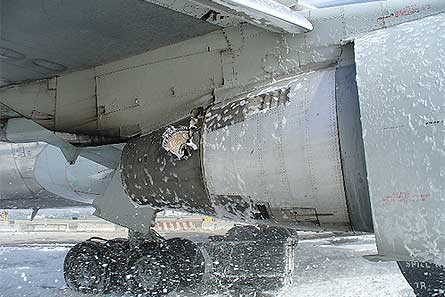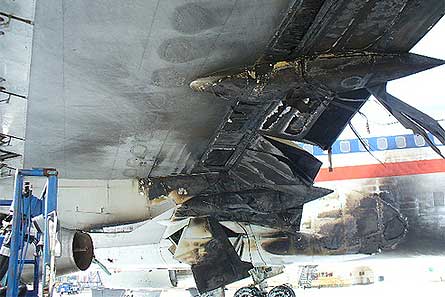General Electric is investigating the cause of an apparent uncontained engine failure which caused extensive damage to an American Airlines Boeing 767-200 at Los Angeles on Friday.
The aircraft (N330AA) was undergoing a ground run-up of the (left) No.1 engine when the problem occurred. The CF6-80A was being tested after the crew bringing the aircraft in from the New York reported abnormal power response from the engine during the flight.
|
|
 |
 |
Reports say the engine was at more than 90% power when the failure occurred, either in the shaft or the high pressure turbine (HPT) area. Judging by images of the incident that have since appeared on the Internet, it appears that an HPT disc ruptured, puncturing the fuel tank in the wing near the trailing edge, slicing partially through the belly of the aircraft and damaging the keel beam. The No.2 engine was also damaged by the exploding debris and the fuel tank on the right wing punctured.
The wing puncture also caused fuel to be spilled on the tarmac, and that along with a fuel line rupture caused a major fire which engulfed the wing and the rear fuselage before it was put out. Fortunately a Los Angeles airport fire department was close by, and got the fire under control while the the maintenance crew escaped The damage to the wing trailing edge, flaps, aft fuselage, fuel tanks on both sides and the keel beam makes it likely the aircraft will be declared a write-off. The surrounding runways and taxiways were closed off for some time immediately after the incident while a FOD search was carried out. Parts of the second HPT disc were reportedly still missing as of yesterday.
The CF6-80 has been hit by similar issues in the past, and as recently as January 2003 was the subject of a US Federal Aviation Administration airworthiness directive (AD) calling for inspections of the HPT disc. The AD was prompted by an incident on 8 December, 2002, when a 767-200 equipped with GE CF6-80A series engines experienced an uncontained failure of a stage 1 HPT rotor disc during climb. The FAA said at the time the “results of the investigation indicated that the stage 1 HPT rotor disc failure was the result of a crack that initiated in an aft corner edge of the bottom of a dovetail slot. The crack propagated in fatigue to critical crack size, and subsequently resulted in disc rupture and separation.”
The FAA also notes that in September 2000, a U.S. operator experienced a similar uncontained failure of the stage 1 HPT rotor disk during a ground maintenance run of a CF6-80C2 engine. Again it said “the investigation of that failure had indicated that a crack initiated in the dovetail slot bottom aft edge. The root cause of the crack initiation remains unknown. However, cracks, burrs, or damage sustained in the dovetail slot bottom corner radii from improper handling and processing during new part manufacture and/or during maintenance were suspect for the September 2000 event.”
A previous AD, which became effective in June 2001, was also issued to mandate inspections of the CF6-80C2 stage 1 HPT rotor disc dovetail slot bottoms.
Source: Flight International
























